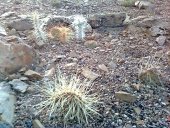
 2
2





 1
1




List of Bryant RedHawk's Epic Soil Series Threads We love visitors, that's why we live in a secluded cabin deep in the woods. "Buzzard's Roost (Asnikiye Heca) Farm." Promoting permaculture to save our planet.
 1
1




Pecan Media: food forestry and forest garden ebooks
Now available: The Native Persimmon (centennial edition)
 2
2








Invasive plants are Earth's way of insisting we notice her medicines. Stephen Herrod Buhner
Everyone learns what works by learning what doesn't work. Stephen Herrod Buhner




Anne Miller wrote:Deb, have you experimented with cactus to know how long it will take to control/lower blood pressure or how much you will have to eat?
Thanks everyone for the great info.




Idle dreamer




Tyler Ludens wrote:Deb, do the fruits need to be eaten fresh to control BP, or can they be cooked? I bury a lot of less palatable things in curries, so I can imagine adding cactus fruits to curry as well.




Invasive plants are Earth's way of insisting we notice her medicines. Stephen Herrod Buhner
Everyone learns what works by learning what doesn't work. Stephen Herrod Buhner








 1
1





 2
2




Deb Rebel wrote:That cholla cutting bit me pretty badly today.














![Filename: opuntia-basilaris-flower.jpg
Description: Opuntia basilaris flowering [Thumbnail for opuntia-basilaris-flower.jpg]](/t/63070/a/47982/opuntia-basilaris-flower.jpg)









 2
2




John Elliott wrote:Chollas generally have yellow flowers (where I grew up).
Why don't you try something a little less dangerous for blood pressure? Like Hibiscus sabdariffa? Although if you punch enough holes with cholla spines, that would let down the pressure.










 3
3




 1
1




 1
1




Idle dreamer

 1
1




Deb Rebel wrote:Deadly gorgeous Cholla there. What color does it bloom?
 1
1




 1
1




 2
2












 Personally I go to some lengths to remove spiky things from my garden; I like to garden barefoot. These just look plain nasty.
Personally I go to some lengths to remove spiky things from my garden; I like to garden barefoot. These just look plain nasty.
Moderator, Treatment Free Beekeepers group on Facebook.
https://www.facebook.com/groups/treatmentfreebeekeepers/





 2
2





 1
1








 2
2








Dan Boone wrote:Pretty!
I've got a wild opuntia here on the property but the fruit is no thicker than a carpenter's pencil and quite juiceless, just dry seeds.
Gail Gardner @GrowMap
Small Business Marketing Strategist, lived on an organic farm in SE Oklahoma, but moved where I can plant more trees.




Tyler Ludens wrote:Deb, do the fruits need to be eaten fresh to control BP, or can they be cooked? I bury a lot of less palatable things in curries, so I can imagine adding cactus fruits to curry as well.
Gail Gardner @GrowMap
Small Business Marketing Strategist, lived on an organic farm in SE Oklahoma, but moved where I can plant more trees.





 1
1




 1
1




Joseph Lofthouse wrote:Nopales are ready to harvest!!! Help! I don't know how to deal with prickly pear cactus pads at market... What price should I ask? What do I tell people when they ask how to prepare them? What's your favorite preparation method? (I ate them raw and sauteed today.) Should I remove the spines before taking them to market? How much more would you pay if I remove the spines? Should I refrigerate them on the way to market? Should I water the patch before harvest so that they are moister? Or should they be more dry when harvested? Anything else I should know about nopales?

|
She'll be back. I'm just gonna wait here. With this tiny ad:
Learn Permaculture through a little hard work
https://wheaton-labs.com/bootcamp
|







